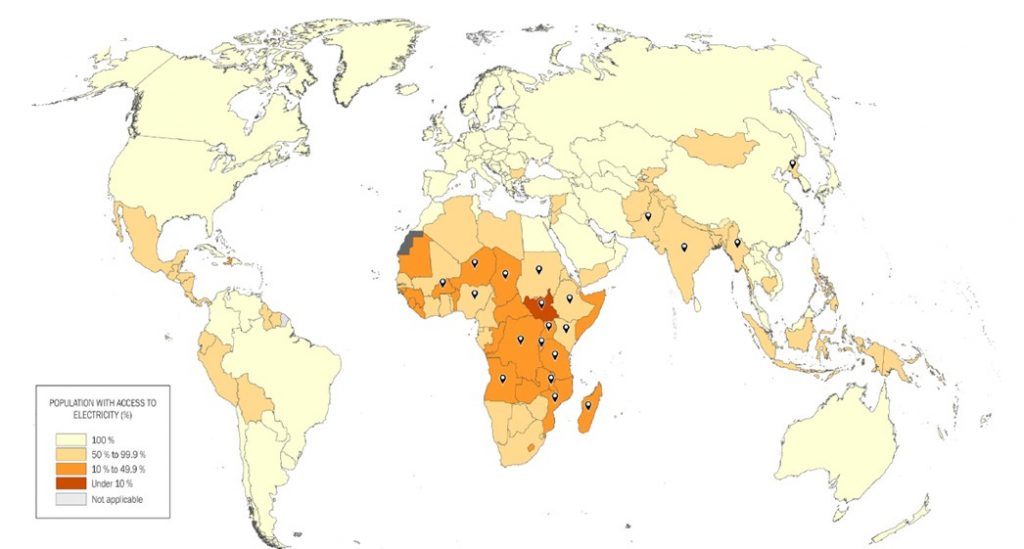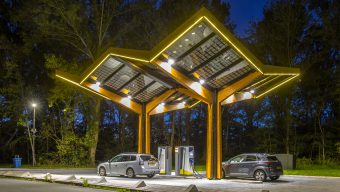The transition towards a sustainable world requires a systemic understanding of environmental, social, and economic matters and how they all interweave in inextricable and complex ways. A paradigmatic example of the intersection of the three is the provision of environmentally responsible and socially inclusive access to energy for all. According to the International Energy Agency (IEA), the number of people globally without access to energy increased in 2022 by six million to roughly 760 million. Paradoxically, despite contributing the least to climate change, many of these people are climate-vulnerable. On a regional basis, Sub-Saharan Africa remains the least electrified region. Even with policies in place to reduce the number of people without access to electricity around the world, the IEA estimates that there will still be 650 million people without in 2030.

Share of the population without access to electricity in 2022
Source: World Bank and IEA
What does it mean to be off-grid? Not having access to electricity means you cannot switch on a light after dark to study or cook, cannot charge your phone to connect with the rest of the world, access the radio or TV for news, and much more. The kerosene lamps or open fire pits that are currently and prevalently used emit toxic fumes, cause deadly accidents, and don’t offer the necessary light for children to study without damaging their eyesight. According to the World Health Organization, indoor air pollution leads to 3.2 premature deaths every year. Being off the grid has noticeable adverse effects on nearly all elements contributing to the sustainable development of emerging markets, such as health, education, connectivity and more.
Off-grid solar products have emerged as a promising solution and have positively impacted 490 million people living in developing countries by bringing light, education, safety and security, and income generation, to provide just a few examples.
Off-grid solar
An off-grid solar (OGS) product is usually a combination of a solar panel, a battery, and one or multiple lights. Depending on the panel and battery size and the number of lights and additional appliance(s) that it can power, we categorize them as solar lanterns, multi-light systems, and solar home systems.
Off-grid solar technologies are expected to be the most cost-effective solution for 41% of new household connections between 2020 and 2030. These products are set up in people’s homes far away from the national grid and thus usually use traditional fuels (such as kerosene lanterns or fire) to light up their homes. The global OGS market is valued at an estimated $2.8 billion annually, with an estimated 30 million units sold only in 2021 across all developing countries.
We already see the positive impact of these products, as the number of people accessing solar energy kits has grown from 420 million in 2019 to over 490 million people by the end of 2021, with more people gaining higher ‘Tier 2’ levels of access. The Multi-Tier System is a scheme developed by the World Bank to categorize the type of access to electricity (and cooking), acknowledging that electricity access is a spectrum of service levels. For example, Tier 2 would mean having at least four hours of daily available electricity access and at least two at night.
Most solar kit customers are rural, male, and living under the poverty line of $3.10. Given the prevalence of consumers living under the poverty line, Paygo technologies (tools that allow customers to pay for their OGS units in installments) have played a crucial role in increasing affordability. Today, multiple companies specialize in Paygo and CRM services, leveraging the high penetration of mobile money wallets that can be used to pay for the OGS systems.
In terms of fundraising, the OGS industry has been growing. Between 2012 and 2021, the off-grid solar sector raised $2.3 billion in capital through debt, equity, and grants, and in 2022, 58 companies received investment commitments amounting to $746 million, representing a 63% growth in investment over the previous year. International players have raised the majority of this funding.
The impact so far
These products are already generating a wealth of benefits for their users. Some of the more important ones are:
- Money savings and income generation. Using OGS devices can save households money as they replace expenditure on kerosene, batteries, or charging mobile phones, although this depends on the size of the system. Increased economic activity and income generation are crucial outcomes for households to be financially better off from using a larger SHS. Moreover, working for long hours is the most common way in which end users report being able to undertake more economic activity through the acquisition of a solar device. OGS devices also enable consumers to start new income-generating activities or improve an existing business.
- Jobs created. The off-grid solar sector is powering over 10 million micro and small enterprises and creating hundreds of thousands of clean energy jobs directly within the industry.
- Financial inclusion. Through the PAYGo business model, the off-grid sector has expanded financial inclusion to those in remote areas and motivated the adoption of mobile money.
- Health and safety. Households using OGS products report positive impacts on their health and safety. Solar lighting’s major health benefit to households is the replacement of kerosene lanterns, which emit fine particulates and toxic gases that can harm health and cause burns or fires.
- Children study for longer hours if they have an OGS product; however, there is no definitive link to improved educational outcomes. Evidence suggests that study times are often shifted to after dark, freeing daylight hours for other activities.
- Replacing kerosene lanterns with solar lighting has already avoided an estimated 190 million tons of CO2e, equivalent to taking 51 coal-fired power plants offline for a year, while replacing diesel generators also has clear emissions reduction benefits. Although building solar panels generates CO2 emissions and the technology to recycle them is still suboptimal, the alternatives are much worse.
Not there quite yet, though
Many of the millions of people currently living without access to electricity, continue to use kerosene lighting, thus, putting their health at risk and emitting tons of CO2. Why does this social and environmental problem prevail even though we have the technology to solve it? Although reasons vary by country, the number 1 issue is economic: the very low ability to pay the customers that these products are catered for. Declining income levels further exacerbate this income matter due to the pandemic. Moreover, during the pandemic, supply chain-related disruptions have increased nominal prices for OGS products. Finally, Paygo is essential to address affordability but insufficient to close the gap.
Local startups can know their environment, customers, and pain points much better than international companies. However, they struggle to attract investment. In fact, the lion’s share of the funding that has been raised was done so by US or EU-owned companies. Their capacities to scale are limited due to local skills and experience in the sector and deficient funding.
Unleashing the potential of off grid solar on the ground
The way forward exists and can be dissected under three pillars: funding, awareness, and an enabling environment. Naturally, these are not exhaustive but represent the main ones.
Firstly, unlocking funding for locally owned companies is critical to unleashing their potential. Selling off-grid solar products on PAYGO is very capital intensive, given that these companies usually have to buy products upfront and then resell them in installments. Thus, their receivables are quite high. Naturally, this funding will need to be sourced from public and private actors.
Secondly, increasing awareness amongst governments that OGS solutions represent the cheapest way to reach the most remote customers in their countries should become one of the elements to be included in bilateral or multilateral aid and development programs. It is essential to have governments’ sponsorship and support when implementing projects promoting OGS technologies. Rural electrification through OGS should be included in national rural electrification strategies. Fortunately, this is already happening through many organizations such as the World Bank, USAID, CLASP etc.
Finally, there must be an effort to improve the enabling environment for OGS companies across the entire value chain (manufacturers, PAYGO providers, distributors, after-sales providers etc.). This can be done by removing import taxes for OGS products, adopting quality standards for the import of these products, increasing banks’ awareness of OGS PAYGO companies for them to be more comfortable lending to them, and awareness campaigns to increase people’s understanding of OGS products. IFC’s Lighting Global Program has done much of this work in countries across Africa and Asia, but more is needed. The program should be taken as an example and should be implemented in many more countries.
These products’ positive impact on their beneficiaries and the planet is enormous. Despite the long and complex way ahead, it is achievable and contribution from all actors at all levels, including the development actors, is crucial. As per the title of Pahl-Wostl et al.’s paper, we need to move “From applying panaceas to mastering complexity.” This framing, which they apply to water management, is indeed relevant to every topic of sustainability. To scale up already existing solutions and develop even better ones, we must consider the problems from the social, environmental, and economic perspectives.
© IE Insights.











